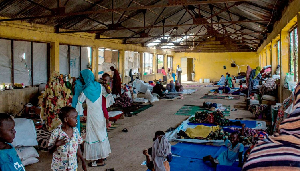As the sun sets over the refugee camp in Blue Nile State, casting long shadows over rows of makeshift tents, a small group of children huddle together. Their eyes are marked with anxiety and fatigue, as shown in a video shared by a charity group working to rescue children affected by the war in Sudan.
The children are the survivors of a conflict that has torn their lives apart. Among them is six-year-old Ahmed who lost his parents and older siblings in the chaos of the conflict. Aid workers warn that the children may have survived, but the trauma they face could last a lifetime.
In the last six weeks, the camp has seen an alarming influx of unaccompanied minors. Every day, weary young faces arrive, having journeyed alone through a war-torn landscape, carrying mostly nothing but the heavy burden of both physical injuries and emotional trauma.
As violence escalates across Sudan, the growing number of unaccompanied and separated children underscores the worsening humanitarian crisis.
Over the past six weeks, nearly 500 children have arrived alone in Blue Nile and Gedaref states, fleeing the latest wave of conflict that has ravaged the country for 16 months.
The conflict in Sudan, marked by intense fighting between the army (SAF), led by Gen Abdel Fattah al-Burhan, and the paramilitary Rapid Support Forces (RSF) under his former deputy Mohamed Hamdan Daglo, has resulted in a devastating humanitarian crisis.
Nearly 16,000 people have been killed and more than 33,000 injured since the conflict began in April 2023, and an estimated 10.7 million people (2.1 million families) are now internally displaced in Sudan, with many fleeing to neighbouring countries in search of safety.
The conflict, which escalated on June 29 with heavy fighting in Sinja, the capital of Sennar State, has displaced some 725,000 people, more than half of whom are children, according to the International Organisation for Migration's Displacement Tracking Matrix (IOM DTM). Many families displaced from Khartoum and Gazira earlier in the conflict are now seeking refuge in Blue Nile and Gedaref, with increasing numbers of children arriving without their parents.
Between June 1 and July 31, DTM Sudan, which monitors hotspots of violence, reported 55 incidents of displacement in various locations across several states.
Ahmed's experience is echoed by many of the children arriving at the camp. According to the UK charity Save the Children, at least 451 children made the dangerous journey alone to safety between June 29 and August 14 – the highest number recorded in such a short period since the conflict began in April 2023.
Many of these children are on the move for the second or third time, having first sought refuge in Sinja after fleeing earlier conflicts in Khartoum and Gazira states.
This alarming trend underscores the severe impact of the ongoing violence on the youngest and most vulnerable.
The ongoing rainy season, marked by flooding and deaths, has exacerbated the world's largest displacement crisis, with 6.7 million children now forced from their homes.
“Our staff in Blue Nile and Gedaref states are receiving at least nine children without their parents every day in camps for displaced people,” says Mary Lupul, the Humanitarian Director for Save the Children in Sudan.
“These children have seen their homes, hospitals, playgrounds and schools bombed, looted and occupied, and have been separated from their parents or guardians. They’ve lost loved ones and been subject to unspeakable violence. We know that children who have been separated from families are at much higher risk of violence, abuse and exploitation, including trafficking, recruitment into armed groups and sexual and gender-based violence.”
The charity says it has provided a kind of 'home' environment for the children to settle down. But this may require wider cooperation as the situation is not unique to Sennar, as the same has been seen in other states such as Blue Nile where violence has recently raged.
The UN Office for the Coordination of Humanitarian Affairs (OCHA) reports that the humanitarian response in Sudan remains critically underfunded, with only 37.9 percent of the UN's $2.7 billion response plan covered.
In Sudan, the Ministry of Interior has reported that recent heavy rains have caused at least 68 deaths and worsened the plight of millions of people already struggling in what is now the world's largest displacement crisis, leading to shortages and soaring prices of basic commodities such as wheat flour, oil, cereals and onions.
A report released last week by the Intergovernmental Authority on Development (IGAD) said some 25.6 million people -- more than half of Sudan's population -- are facing acute hunger, including more than 755,000 people on the brink of famine, according to the latest analysis.
Meanwhile, the World Health Organization (WHO) reported at the weekend that cholera has killed 28 people in the country in just one month.
Africa News of Wednesday, 11 September 2024
Source: theeastafrican.co.ke

















